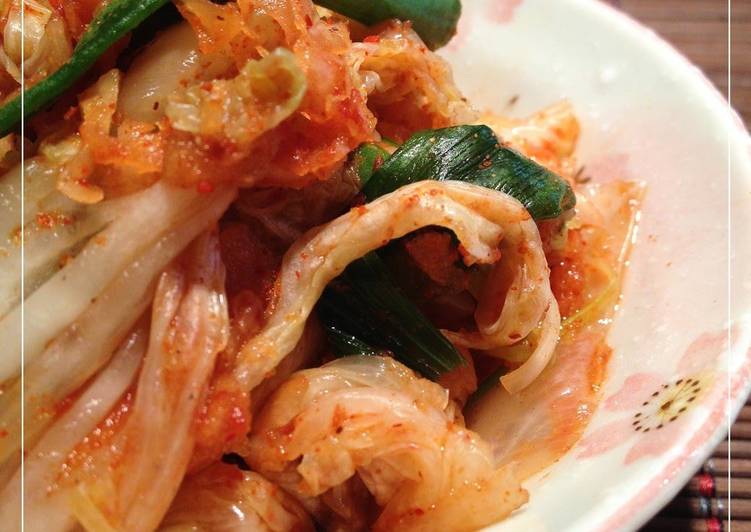Flavour of Korea: Simple Homemade Kimchi. Great recipe for Flavour of Korea: Simple Homemade Kimchi. This is a recipe I came up with after buying lots of different kinds of kimchi, tasting them, and then comparing the ingredients on the package. It got the approval of my Korean friends.
 It's kind of like Korean sauerkraut. Today I'd like to share an easier version of Korean kimchi. So many Korean dishes are made with well-fermented kimchi, such as kimchi jjigae, kimchi mandu, kimchi bibim guksu, kimchi fried rice, kimchi jeon, tofu kimchi, and many more. You can have Flavour of Korea: Simple Homemade Kimchi using 15 ingredients and 8 steps. Here is how you achieve it.
It's kind of like Korean sauerkraut. Today I'd like to share an easier version of Korean kimchi. So many Korean dishes are made with well-fermented kimchi, such as kimchi jjigae, kimchi mandu, kimchi bibim guksu, kimchi fried rice, kimchi jeon, tofu kimchi, and many more. You can have Flavour of Korea: Simple Homemade Kimchi using 15 ingredients and 8 steps. Here is how you achieve it.
Ingredients of Flavour of Korea: Simple Homemade Kimchi
- Prepare of Chinese or napa cabbage.
- Prepare of Salt.
- You need of Yangnyeom:.
- Prepare of Apple.
- Prepare of Garlic.
- It's of thumb's worth Ginger.
- You need of Cooled dashi stock soup....refer to ★.
- Prepare of Sugar (dissolve in the dashi).
- You need of Other:.
- It's of Green onions (chopped into 4 cm sections).
- Prepare of Daikon radish (finely chopped).
- It's of Chili peppers (coarsely ground).
- It's of Chili pepper powder.
- Prepare of Salt-fermented shrimp paste.
- You need of Or fish sauce.
For the most part, the base of vegetables is Chinese (also called Napa) cabbage, garlic and ginger. The most common vegetables added to that are green onions, daikon radish and carrots. Place vegetables, ginger, garlic, chile flakes, sea salt, and whey in a bowl and pound with a wooden pounder or a meat hammer to release juices. Place in a quart-sized, wide-mouth mason jar and press down firmly with a pounder or meat hammer until juices come to the top of the cabbage.
Flavour of Korea: Simple Homemade Kimchi step by step
- Wash the Chinese cabbage and chop into bite-sized pieces. Transfer the cabbage to a large bowl and work in the salt with your fingers. Use a bowl or plate to apply weight to the cabbage and let soak for 3 hours..
- Discard the salt water and replace with fresh water. Rinse 3 or more times until the cabbage has a lightly salted flavour. Drain the cabbage..
- Whilst the cabbage is soaking, peel the apple, then to prepare the yangnyeom, either grate the or add the ingredients to a food processor, then mix in the ingredients listed under "Other". Adjust the amount of chili pepper to taste..
- Take a handful of drained cabbage at a time and wring it well. Add a handful of cabbage and some of the mixture from Step 3 alternately into a plastic bag or resealable container to give the cabbage a good coating..
- Leave the mixture to rest at room temperature for half a day and then store in the refrigerator. You can eat it from the next day. If you make this recipe in the morning you can serve it at lunch time..
- ★ If you are using nam pla fish sauce instead of salt-fermented shrimp paste, there will be a higher water content; in that case, reduce the amount of dashi stock to 120 ml. I recommend using the salt-fermented shrimp paste..
- Chili pepper is very spicy so adjust the amount whilst checking the taste every so often. If you're using Korean chili peppers, they aren't as spicy, so you could use a lot..
- How about serving this kimchi with some samgyeopsal? https://cookpad.com/us/recipes/156646-samgyeopsal-korean-style-pork-belly-bbq-at-home.
Directions Kimchi (김치) consists of cabbage that has been salted and fermented, over a number of days, in a spicy sauce made up from a large number of ingredients including chilli powder, spring onions, fish sauce and onion. All the kimchi ingredients: carrots, green onions, ginger, garlic, Korean coarse red chile powder, fish sauce, sweet rice powder, napa cabbage and daikon radish (here I used salad turnips instead) Garlic, ginger, the white parts of scallions, Korean Red Pepper Powder*, fish sauce, unsweetened pear or apple juice, miso paste, and whatnot go into the food processor or blender. Obliterate and smash it all into a lovely, red, fabulous smelling paste. However, for the main flavor, you could find kimchi to include umami, spicy, and sour. The flavor also depends on the vegetables, the amount of sugar or salt used, and the length of fermentation.
Comments
Post a Comment